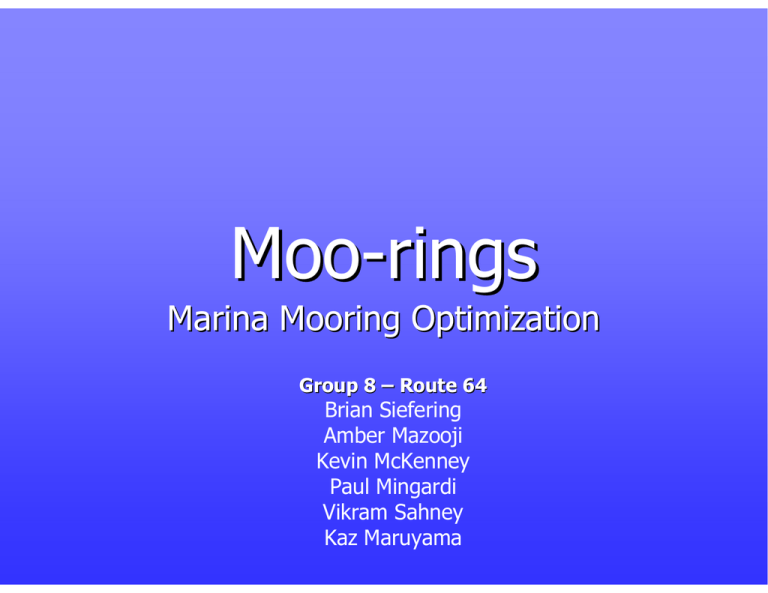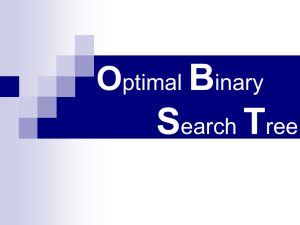Document 13620507
advertisement

Moo-rings rings Marina Mooring Optimization Optimization Group 8 – Route 64 Brian Siefering Amber Mazooji Kevin McKenney Paul Mingardi Vikram Sahney Kaz Maruyama Presentation Overview Overview • Introduction • Problem Description Description • Assumptions • Model Formulation • Analysis • Conclusions • Lessons Learned • Questions Introduction • What is a mooring? • Why an optimization problem? Mooring Buoy Mooring Line Line Secured to Bedrock Problem Motivation Motivation “Moorings are so scarce that in towns such as Orleans or Truro, the wait to get one can be as long as 20 years. In Sandwich, which has no moorings, only slips, the waiting list is closed with 1,200 waiting for a mere 200 spaces.” Cape Cod Times 8/10/2003 Problem Description Objective: Maximize Revenue! (also increase number of moorings in marina) Decision Variables: Boat Locations Dock Channel Problem Description Description Marina Top View Cross Section 8’ Exit Channel Depth, z y (xi,yi) x (0,0) Dock 4’ Assumptions Assumptions •• Marina: – – The bottom of the marina is linear, sloping down in the +y direction. – – Tide change is 2 feet or less. • Moorings: – – Mooring lines are weightless. – – Moorings can and will be moved every year. – – At high tide, the mooring line angle is 30. • Boats – – Boats are between 15’ and 40’ in length. – – Boats are classified into two categories based on their hull depth: boats with hull depths less than 4’ and boats with hull depths between 4’ and 8’. • Placement – – – – – – – – Moorings can be precisely placed. The minimum separation needed between boat sweeps is five feet. Bow line length is negligible. Boats will be able to leave moorings without specified lanes designated in a marina. Model Formulation Marina Top View Exit Harbor Depth Cross Section 8’ Channel Depth, z y (xi,yi) x (0,0) Dock 4’ ⎡ (D max − D min )⎤ yi z i = D min + ⎢ ⎥ y max ⎦ ⎣ for 0 < yi < y max Model Formulation Boat Sweep Radius Swing Radius, r2 Buoy r1 Boat Length, L Buffer, B Sea level with high tide Tide, T Sea level with low tide Depth, z θ1 h θ2 zi + T hi = cos θ1 h ⎡ ⎛ z ⎞⎤ r2,i = zi tan ⎢arccos⎜ ⎟⎥ + Li + B ⎝ h ⎠⎦ ⎣ Model Formulation Formulation Mooring Location Boundary Constraints Prevent boat location and swing circle from exceeding the marina boundaries xi + r2,i < X max ∀i xi − r2,i < X min ∀i yi − r2,i < Ymin ∀i yi + r2,i < Ymax ∀i Model Formulation Formulation Mooring Location Boundary Constraint Marina Top View Entrance Cross Section 8’ Channel Depth, z r2,i (xi,yi) rk y (xk,yk) x Dock (0,0) 4’ (xi − xk ) + ( yi − yk ) 2 2 > r2,i + rk ∀i, k < i Model Formulation Formulation Mooring Depth Boundary Constraint Marina Top View Entrance Cross Section 8’ Channel r2,i (xi,yi) Depth, z y x (0,0) Dock 4’ ⎛ Dmax − Dmin ⎞ ⎟⎟ ( yi − r2,i ) − Di > 0 Dmin + ⎜⎜ ⎠ ⎝ Ymax Model Formulation Formulation Dock and Harbor Channel Proximity Price Combined Proximity Pricing Entrance Channel (Xmax,Ymax) Iso price lines PD ,max − PD ,min PD = DT Optimal Price Region DT y x (Xmin,Ymin) PC ,max − PC ,min PC = DT Dock DT = ( X max − X min ) 2 + (Ymax − Ymin ) 2 Model Formulation Objective Function LF = Length Fee = ∑∑ Pj Li , j j i DF = Depth Fee = ∑ PH 1 Di + PH 2 (1 − Di ) i DPF = Dock Pr oximity Fee = ∑ PD ,max − PD ( X max − xi )2 + (Ymin − yi )2 i CPF = Channel Pr oximity Fee = ∑ PC ,max − PC (Ymax − y i )2 + ( X min − xi )2 i Mooring Fee = LF + DF + DPF + CPF Analysis Run 1 – Constant Harbor Depth and No Channel Exit Fee Exit Test 1 - Fixed water depth, no harbor exit fee 500 Y Coordinate 424, 417 303, 405 400 209, 336 489, 320 373, 312 300 281, 257 188, 231 358, 217 200 277, 149 383, 134 162, 128 509, 225 434, 210 489, 130 100 327, 55 231, 46 0 0 100 200 300 X Coordinate $ $ Doc $ $ $ $ $ 423, 46 400 509, 36 500 Analysis Run 2 – Constant Harbor Depth and No Dock Fee $ $ $ Exit Test 2 - Fixed water depth, no dock fee $ $ 41, 509 500 135, 489 252, 489 369, 488 41, 433 400 108, 396 310, 399 204, 383 408, 357 Y Coordinate 43, 356 125, 311 300 308, 303 215, 277 51, 249 200 396, 241 287, 198 144, 197 216, 119 100 0 0 100 200 300 400 500 X Coordinate Doc Analysis Run 3 – Fixed Harbor Depth, Equal Proximity Pricing $ $ $ Exit Test 3 - Fixed water depth, equal dock and harbor channel exit fee $ $ 500 51, 499 144, 474 259, 439 76, 406 400 Y Coordinate 169, 381 98, 301 300 351, 367 194, 298 269, 316 428, 280 332, 272 263, 239 173, 203 200 366, 193 471, 171 272, 143 100 392, 99 489, 56 0 0 100 200 300 X Coordinate 400 $ Doc $ $ $ $ 500 Analysis Run 4 – Variable water depth Exit Boats with deep hulls > 8’ Test 4 - Variable water depth, no exit proximity 600 307, 565 196, 542 410, 552 500 125, 454 329, 454 227, 444 441, 454 8 feet deep Y Coordinate 400 300 392, 274 296, 217 200 290, 139 100 292, 51 0 375, 207 376, 118 378, 31 0, 0 0 100 200 300 X Coordinate 400 462, 274 453, 196 464, 118 454, 41 $ $ Doc $ $ $ 500 Boats with shallow hulls < 8’ Results Marina Mooring Optimization with 18 Boats Typical Marina 500 500 343, 427 470, 417 400 174, 329 287, 329 399, 329 501, 319 300 469, 244 330, 237 255, 206 200 512, 188 410, 176 VS. Y Coordinate Y Coordinate 400 300 139, 411 256, 411 373, 411 489, 411 139, 294 256, 294 373, 294 489, 294 139, 177 256, 177 373, 177 489, 177 139, 61 256, 61 373, 61 489, 61 200 311, 149 513, 118 100 371, 84 449, 96 279, 51 504, 41 428, 31 0 0 0, 0 0 100 100 200 300 400 500 0, 0 0 100 200 300 400 X Coordinate X Coordinate Revenue = $6,706.93 Revenue = $5,523.56 21.4% IMPROVEMENT !!! 500 Conclusions • Optimization can significantly increase marina profits. • Optimization can significantly increase number of moorings in marina • Model is flexible to accommodate constraints of any marina Lessons Learned • Need more powerful solver to increase number • • • of boats and constraints in optimization. Need separate proximity pricing scheme for each boat length category. Would be convenient to include a boat adding algorithm. There are ways to make solver behave better. Questions ?
